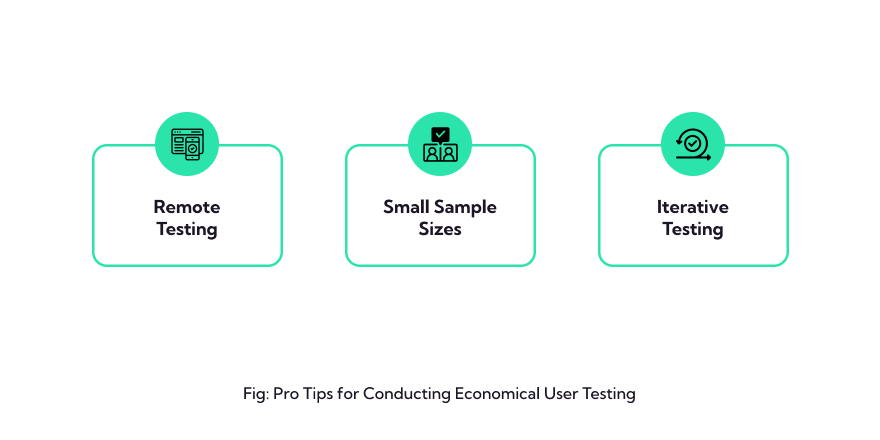Offices: Gurgaon, Jaipur, Indore, London, Dubai, Sweden
The economics of user testing

Crafting a stellar user experience (UX) and a sleek user interface (UI) is the holy grail of digital design. Yet, building a smooth, user-friendly interface isn’t as straightforward as it may seem. Guessing and making educated assumptions about what users want and need can lead to risky design choices. Here’s where user testing steps in, serving as the indispensable tool to uncover insights and optimize your design. In this blog, we’ll dive deep into the world of UI/UX potential and explore why user testing is an absolute must for any design project.
The architect of user experience
Before we plunge into the importance of user testing, it’s crucial to grasp the significance of UI/UX in the digital realm. UI refers to the user interface—the visual components, buttons, and interactive elements of a product or website. UX, on the other hand, encompasses the overall user experience, including how a user interacts with the interface, the efficiency of navigation, and the emotional responses it evokes.
A well-crafted UI/UX doesn’t just make a product look good but also ensures it’s intuitive, efficient, and enjoyable to use. It’s the bedrock upon which a positive user experience is constructed.
Cause and effect relationship
In the realm of UI/UX design, it’s not uncommon for designers and developers to be lured into the tempting embrace of their own assumptions or industry-standard practices. While these insights may hold some value, they often fall short of addressing the multifaceted needs and preferences of real users, leading to several common pitfalls associated with assumption-based design.
Firstly, such an approach can introduce bias into the design, as assumptions are often tainted by a designer’s personal preferences or experiences, resulting in designs that fail to resonate with the intended audience. Secondly, crucial user needs and pain points may remain concealed, resulting in missed opportunities for design enhancements that could greatly benefit the user experience. Thirdly, when a design doesn’t align with user expectations, it can breed frustration among users, leading to higher bounce rates and reduced conversion rates. Lastly, assuming that everything is on the right track until late in the development process can result in costly and time-consuming redesigns when issues finally come to light. These pitfalls underscore the critical importance of user testing in achieving successful and user-centric UI/UX design.
User testing is the remedy for these pitfalls, challenging common misconceptions and ensuring that design choices are anchored in user feedback rather than assumptions. Let’s delve into why user testing is indispensable:

The ABCs of user testing
User testing entails recruiting actual users to interact with a product or interface while capturing their thoughts, actions, and feedback. This process offers several priceless advantages:
Spotting inconsistencies and design flaws: User testing is a spotlight that reveals usability problems, inconsistencies, and design flaws that may remain hidden otherwise.
Authentic user feedback: bridging the gap: It bridges the chasm between designer assumptions and user expectations by providing insights straight from the target audience.
Enhancing accessibility through user testing: User testing can unearth accessibility hurdles, ensuring that your design is all-inclusive and aligns with accessibility standards.
Cost-efficiency of user testing: Although some argue that user testing is expensive, it’s far more budget-friendly than dealing with usability issues post-launch.
Infusing user testing into the design process
To fully harness the potential of user testing, it’s essential to weave it seamlessly into your design process. Start by establishing clear objectives for your testing, whether it’s to uncover specific usability challenges, gauge user satisfaction, or evaluate the overall user experience. Next, carefully consider the most suitable user testing approach, whether it’s moderated or unmoderated testing, remote or in-person sessions, or even guerrilla testing, depending on your specific testing goals.
Additionally, ensure that the participants you recruit for testing reflect the diversity of your target audience in terms of demographics and user behaviors. Finally, don’t overlook the critical step of analyzing test results with precision. Use these insights to drive iterative design enhancements, allowing your UI/UX to continually evolve and align with user expectations, ultimately delivering an exceptional user experience.
Concluding remarks
In closing, user testing is the master key to unlocking the full potential of UI/UX design. It yields priceless insights, wards off costly missteps, and guarantees that your product or website genuinely resonates with your target audience. By challenging assumptions, embracing user feedback, and integrating testing into your design process, you can create UI/UX experiences that shine brightly in the competitive digital landscape. Remember, user testing isn’t a luxury; it’s a necessity for success in today’s user-centric design realm.
Reach out to our Sales Team.
Recent Posts
Wish to live a culture beyond tech ?
Quick links
Contact
-
INDIA
-
-
-
37B - Thinkvalley , Sector 32 - Gurgaon Haryana - 122002
-
J-2, Jhalana Institutional Area, Jhalana Doongri, Jaipur, Rajasthan 302004
-
Incuspaze Co-Work, 208, 2nd Floor, Apollo Premier, Vijaynagar Square, Indore (MP) 452010
Locations
-
UK
-
-
-
Wework, 33 Queen Street, London, England, EC4R 1AP
-
FZCO IFZA Business Park, Dubai Digital Park, Dubai Silicon Oasis, Dubai, United Arab Emirates
-
Herrgardsvagen 12 A 135 53 TYRESO Sweden
© All Copyright 2022 by FIFTYFIVE TECHNOLOGIES


